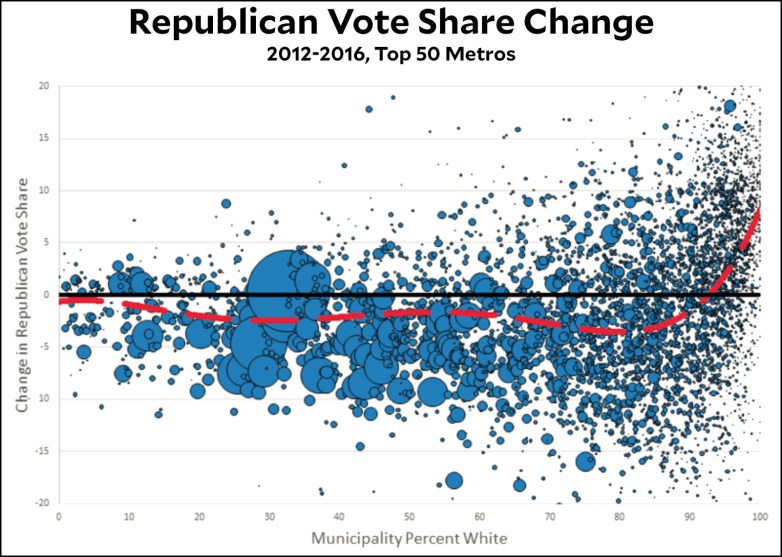
I’ve long been a skeptic of the theory that Donald Trump won the presidency because of his appeal to white racial anxiety. He certainly tried to win on that basis, but exit polling is pretty clear that, nationwide, Trump won no more of the white vote than Mitt Romney did. It’s true that he won the majority of the white vote, but that’s because Republicans always win the majority of the white vote.
But that’s just the 100,000-foot view. What happens when you dig deeper? Thomas Edsall, who consistently writes some of the most thought-provoking analysis around, takes a look at some of the data that’s now starting to trickle out and presents us with this chart that compares the 2012 and 2016 elections:

In most places, even those that are heavily white, the red trendline is below zero, which means Trump won a smaller share of the vote than Romney did. The only places where he outperformed Romney were in the very whitest suburbs and small towns:
The very white municipalities that voted so strongly for Trump believe that they have reason to worry about the racial stability of their neighborhoods….It is in these locales, which are experiencing the earliest signs of minority growth, that anxiety over approaching diversity is strongest. Put another way, anger, fear and animosity toward immigrants and minorities was most politically potent in the communities most insulated from these supposed threats.
….Will Stancil, a research fellow at the Institute on Metropolitan Opportunity who created the chart, explained….“To the extent Trump really resonated, it was in heavily-white areas — and that includes exurbs at the urban fringe, rural areas, and many heavily white second-ring suburbs,” Stancil wrote in his email. “It was his message resonating in those areas that gave him a fighting chance at all.”
This fits a lot of the evidence we have. As it turns out, racial anxiety among whites really isn’t widespread. But it is strong among whites in a very small number of ultra-white communities. That’s why Trump didn’t do unusually well in California, Arizona, New Mexico, or Texas, where the immigrant population is highest. People in those states have lived with Mexican immigrants for a long time and learned that the sky isn’t falling. But farther away, in the very white communities of the upper Midwest, this is still brand new stuff. Unlike Californians, who know better from experience, they buy the idea that immigrants are unusually crime prone and take away everyone’s jobs—and that makes them scared. They’re a receptive audience for Trump’s “Build a Wall” message.
All this said, we’re still left with a question: if the only place Trump did better than Romney was in the very whitest communities, was that enough to push him to victory? After all, he did worse than Romney everywhere else. Well, Edsall has a chart for that too, showing how Trump performed in the upper Midwest, but you’ll have to click the link to see it. (Spoiler alert: the answer is probably yes.)
Edsall finishes up with this:
In some respects, the data gathered by Orfield’s team is good news for Democrats. The core of Trump’s support lies in counties and municipalities like Dravosburg and Elk County, many of which are losing population. They are, in effect, the last gasp of white hegemony.
Still, immense damage has been done….As the public discourse around issues of social welfare, immigration, national security, and a whole host of other issues becomes highly racialized and explicitly hostile, the potential for open racial conflict may rise. Furthermore, as these negative attitudes toward racial outgroups become increasingly tightly tied to parties, polarization increases and gridlock and a lack of legislative compromise ensue.
When I look back at the 2016 election, what is really striking is how much influence over the course of events was exercised by the relatively small numbers of voters in super-white municipalities and counties and by the politician who ignited them — how the last gasp of a small fraction of the electorate set the nation on such a dangerous and destructive course.
Amen. And the faster the politicians who have set fire to this movement—or even merely tolerated it—are sent packing, the better off our country will be.















